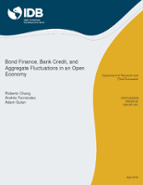Bond Finance, Bank Credit, and Aggregate Fluctuations in an Open Economy
Date
Apr 2016
Corporate sectors in emerging market economies have increased noticeably their reliance on foreign financing, presumably reecting low global interest rates. This trend has largely reflected increased bond issuance by emerging economies' firms, in contrast to the bank loans that dominated capital flows in the past. To shed light on these developments, we develop a stochastic dynamic model of an open economy in which the levels of direct versus intermediated finance are determined endogenously. The model embeds the static, partial equilibrium model of Holmström and Tirole (1997) into a dynamic general equilibrium setting. It generates an increase in both bonds and loans following an exogenous drop in world interest rates; also, the ratio of bonds to loans increases because bank credit becomes relatively more expensive, reflecting the scarcity of bank equity. These implications are in line with empirical observations and highlight the role of equity in the adjustment process. More generally, the model is suitable for studying the interaction between modes of finance and the macroeconomy, and is of independent interest.



